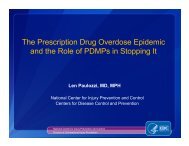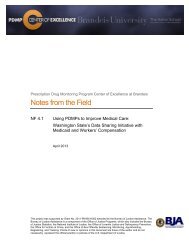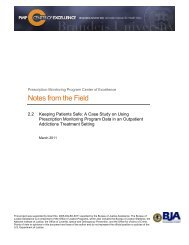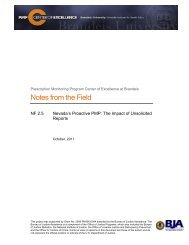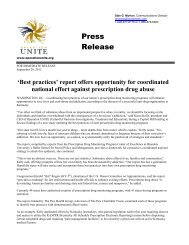Prescription Drug Monitoring Programs - PDMP Center of Excellence
Prescription Drug Monitoring Programs - PDMP Center of Excellence
Prescription Drug Monitoring Programs - PDMP Center of Excellence
Create successful ePaper yourself
Turn your PDF publications into a flip-book with our unique Google optimized e-Paper software.
<strong>Prescription</strong> <strong>Drug</strong> <strong>Monitoring</strong> <strong>Programs</strong>: An Assessment <strong>of</strong> the Evidence for Best Practices 37One <strong>of</strong> the most significant challenges facing <strong>PDMP</strong>s has been the slow increase in enrollment in and use<strong>of</strong> <strong>PDMP</strong>s by prescribers and pharmacists. Rates <strong>of</strong> enrollment among prescribers are well below 50percent in most states. 4 Best practices, therefore, need to be identified for how <strong>PDMP</strong>s can mostefficiently increase enrollment among user groups, including producing enrollments <strong>of</strong>, for example, atleast 50 percent <strong>of</strong> those who wrote 10 or more controlled substance prescriptions in the past year, or<strong>of</strong> prescribers <strong>of</strong> at least 50 percent <strong>of</strong> prescriptions written.To inform best practices in this domain, appropriate rates <strong>of</strong> enrollment need to be studied, taking intoaccount that many providers prescribe infrequently and that a relatively small proportion <strong>of</strong> prescribersare responsible for issuing most controlled substance prescriptions. Data from the Massachusetts <strong>PDMP</strong>indicate that just 30 percent <strong>of</strong> all those who prescribed an opioid at least once in 2011 wereresponsible for 88 percent <strong>of</strong> all opioid prescriptions in 2011 (MADPH Advisory Council Presentation,2012). This suggests that to maximize the effectiveness <strong>of</strong> <strong>PDMP</strong>s, recruitment strategies couldpr<strong>of</strong>itably be focused on the most frequent prescribers <strong>of</strong> those controlled substances implicated inabuse and diversion (see immediately below).1. Proactively identify and conduct outreach to potential high-‐impact usersRationale and evidence for effectiveness: Certain categories <strong>of</strong> potential <strong>PDMP</strong> users are a high priorityfor enrollment given the impact their use <strong>of</strong> <strong>PDMP</strong> data would likely have in improving prescribing anddispensing, and in reducing diversion and abuse <strong>of</strong> prescription drugs. Primary among these are the mostfrequent prescribers <strong>of</strong> controlled substances, such as the top 10 percent in terms <strong>of</strong> prescriptions peryear (Paulozzi, 2011), as well as those prescribers with relatively high proportions <strong>of</strong> suspected doctorshoppers in their practices. Such prescribers are readily identifiable using <strong>PDMP</strong> data and can beencouraged to enroll in and use the <strong>PDMP</strong> via letters and alerts, either electronically or by mail. In 2010,Utah’s <strong>PDMP</strong> analyzed its data to identify top prescribers, then contacted them electronically, resultingin a rapid rise in enrollment among this group. Massachusetts is currently conducting an initiative toidentify prescribers with relatively high proportions <strong>of</strong> doctor shoppers in their practices; theseprescribers are receiving letters suggesting they join and use the Massachusetts <strong>PDMP</strong>. Theseprescribers’ enrollment in and utilization <strong>of</strong> the <strong>PDMP</strong> will be monitored, along with any changes thatmay occur in the proportion <strong>of</strong> possible doctor shoppers in their practices.Current adoption status: Contact with other <strong>PDMP</strong>s is warranted to ascertain which are engaged insimilar efforts and assess outcomes, including on enrollment, utilization, prescribing, doctor shoppingrates, and proportions <strong>of</strong> doctor shoppers among identified frequent prescribers. Outreach to frequentprescribers for enrollment in the <strong>PDMP</strong> will need to be coordinated with licensure boards andinvestigative agencies in case any <strong>of</strong> the identified practitioners happen to be subjects <strong>of</strong> disciplinaryaction or investigations.4According to data during the first half <strong>of</strong> 2010 from Harold Rogers <strong>PDMP</strong> Grant Program, <strong>of</strong> 12 <strong>PDMP</strong>s withoperational online Web portals for prescribers to request prescription history reports, 11 reported 9 to 39 percent<strong>of</strong> prescribers who issued controlled substances prescriptions were registered. Only one state (Hawaii) reported100 percent registration.



